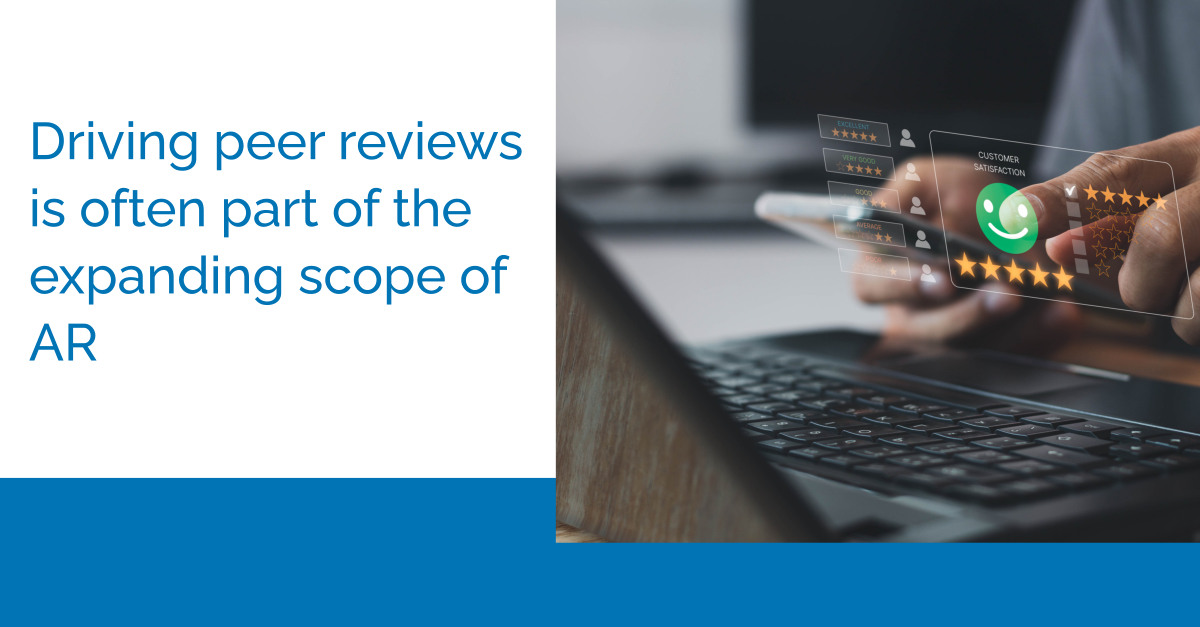Many of the analyst relations (AR) pros we work with “own” their company’s Gartner relationship — and often have responsibility for Gartner Peer Insights, Gartner’s primary platform for end-user reviews and ratings of enterprise technology solutions.
Because the site’s review data has become increasingly relevant and valuable to AR — used, for example, for customer reference information in Magic Quadrant evaluations and to generate separate Voice of the Customer (VOC) research documents — we thought you’d be interested in this actionable VOC update from Gartner… and what it may mean to you.
More markets eligible for VOC reports
To date, Voice of the Customer reports — which synthesize Gartner Peer Insights review data in a given market over an 18-month period — have been generated only in markets for which Gartner produces Magic Quadrant and/or Market Guide research.
But the firm recently shared that, among other updates, “All active markets on the Gartner Peer Insights platform are candidates for Voice of the Customer (VOC) analysis reports.”
This enables many more vendors to appear within (and license/promote) a Gartner-branded research document that also includes a 2×2 comparison grid that bears some similarity to an MQ report. VOC reports factor in user interest and adoption (X axis) and overall experience (Y axis) — categorizing vendors into four quadrants: Customers’ Choice (in the upper right, similar to where MQ Leaders are), Strong Performer, Established, and Aspiring. Companies are listed alphabetically within each quadrant (unlike MQs, no placement dots).
What does this mean for you?
With this more inclusive approach to VOC reports, Gartner Peer Insights becomes an even more important and influential peer review platform for many companies, and merits greater consideration in their AR program strategies.
I was discussing this news with our good friend Patty Wind, co-founder and principal of Wind Communications, an ARInsights partner. Patty shared: “When companies see a Magic Quadrant they’ve participated in get retired, they’re often disappointed since they can’t show customers and prospects a Gartner snapshot of their market anymore, and they don’t have that asset to use externally in sales. But now, having a VOC report opens that option back up — enabling them to be portrayed and positioned in the competitive landscape driven by customer reviews.”
She continued: “On the flip side, we’ve also seen companies wait years without getting a Magic Quadrant in their space. So, having a Voice of the Customer report depicting the landscape is something many will be thrilled about. Even though there are no Gartner analysts tied to the report, it has the Gartner brand, which carries weight among buyers.”
Will your company’s market be spotlighted?
That’s the big question, right? In its recent post, Gartner notes that VOC documents will be produced “when the Gartner Peer Insights team determines that there is end-user interest, sufficient data available on the platform and production capacity.”
Its FAQ further states, “Currently we will only consider a Voice of the Customer document in markets where there is a certain level of market maturity (representing vendors and number of reviews) on the Peer Insights platform, and 5 or more vendors represented in the document.”
When will the VOC research appear?
Keep a close eye on Gartner’s downloadable Voice of the Customer Publication Calendar, which lists planned VOC publication months, review eligibility start and end dates, and VOC Dashboard timeframes, with the dashboard giving “high-level insight into your sourcing efforts for the upcoming publication.” The information from this calendar is also now available in the ARchitect Firm Research Calendar!
Gartner’s latest post on VOC changes also shares that “the amount of time a market is in the ‘review sourcing period’ and the VOC Dashboard [on the Technology Provider Tools Portal, showing eligibility for VOC inclusion] is live may change at any point and may vary from market to market due to market readiness, review volume and more.”
Is your business eligible for inclusion?
Gartner Peer Insights’ recently updated (Sept. 2023) VOC methodology states that the reports include “vendors who have products listed in a particular market (see Gartner Peer Insights Listing Guidelines here), and have received 20 or more eligible reviews along with 15 or more ratings for the ‘Capabilities’ and ‘Support/Delivery’ sub-ratings over the 18 month analysis period. Currently, Gartner Peer Insights limits the number of vendors included in the document to 25.”
Our take
There’s a lot to take in and consider. It’s worth calling out the following 4 observations and recommendations:
1. AR pros are increasingly involved in peer review site activities.
Once firmly — or, arguably, wholly — the domain of customer marketing, peer review sites (also known as “customer review” or “user review” sites) like Gartner Peer Insights now increasingly intersect with analyst relations (AR). In many cases, managing and tracking these reviews is a shared effort. And it’s not just Gartner Peer Insights; platforms like G2, PeerSpot, TrustRadius and others often matter to AR.
That’s because review sites — and reviews in general — are increasingly important to analyst relations activities. For starters, mining customer reviews can yield valuable competitive intelligence, inquiry topics and reference candidates for major evaluations. Plus, with analysts eager to consume user testimonials, positive feedback on peer review sites can be a means to “influence the influencers.”
And perhaps most importantly, as discussed, customer reviews directly impact analyst research. In addition to Gartner tapping into Gartner Peer Insights for Magic Quadrant references, data from TrustRadius powers the Omdia Universe reports. Some peer review sites also generate quadrant-like research reports themselves: In addition to Gartner’s VOC documents, G2 produces quarterly Grid Reports which you can also find in ARchitect Premium Content.
2. Define who owns what.
While we have seen some AR teams own their company’s Gartner Peer Insights strategy outright (an extension of managing their overall Gartner relationship), customer marketing typically takes the lead role with campaigns to drive reviews on Peer Insights and other user review sites — while often partnering with AR.
It’s no secret, though, that AR teams face bandwidth constraints, and so specialized partner agencies often bring value in helping with peer review sites as well. For example, according to Patty Wind at Wind Communications, which has multiple clients with the VOC Customers’ Choice distinction, “We’ve helped create an internal mechanism with our clients: a steady program to source reviews. We also analyze the reviews our clients receive on the platform, and feed those up to the organization in a consumable way — looking at themes, where companies are shining and where there might be problem points. We have a closed-loop process: If a client encounters a negative review, we help them respond through the platform to acknowledge the user’s feedback and hopefully drive resolution. In addition, Gartner makes it easy to use positive quotes from Peer Insights — which they call ‘snippets’ — in social media, so we assist with those communications as well.”
3. Choose the peer review sites you’ll focus on.
Because of the time and effort involved in sourcing customer references — and the need to not “exhaust” the references used — organizations often choose to focus their efforts on the handful of platforms that are most important to them. This typically includes Gartner Peer Insights. Companies also consider each platform’s differentiators and characteristics when deciding where to engage. For instance, G2 provides the opportunity for frequent (quarterly) recognition in well-regarded Grid Reports, and PeerSpot is known for collecting highly detailed customer feedback and long-form reviews.
4. Use technology to efficiently monitor and act on user reviews.
A variety of solutions can help automate tracking customer reviews — saving you time and surfacing important insights.
Knowing the weight that customer reviews carry and their impact on AR, ARInsights synthesizes review data in our Premium Content solution, an add-on to our ARchitect AR productivity software. You can search for, monitor and get instant alerts about reviews on G2, PeerSpot and other sites (selectively/by request), and get a single, consolidated view of review information across multiple platforms. Among other benefits, this helps companies better cultivate references and stay on top of what’s being said about their brand and competitors.
And for companies looking for organized and systematic ways to manage their customer reviews (e.g., tracking who’s been tapped for what, how insights and feedback are being handled, etc.), our flexible Project Manager module makes it easy to create templates for review management programs.
Additional resources
Check out these resources for additional information:
- Gartner Peer Insights webinar: Gartner is hosting a Gartner Peer Insights 101 Vendor Webinar on Wednesday, Oct. 25 (11 a.m. ET), which will include a Q&A session. See the details and registration information here.
- ARchitect User Forum: AR’s increasing awareness of — and involvement in — Gartner Peer Insights and other peer review sites is yet another indication of “the expanding scope of AR,” which is the theme of this year’s ARchitect User Forum. We invite you to register for our virtual event (to be held Nov. 1-2, from 9 a.m.-12 p.m. PT/12-3 p.m. ET each day) where several of our clients will discuss the various ways AR is evolving and how to stay future-ready.
As AR’s role expands, we’re dedicated to helping AR pros stay on top of relevant news and trends, and managing the many influencers — spanning analysts, experts/consultants and even customer influencers/advocates — who matter to their business. Please reach out to us with any questions; we’re here to help: support@arinsights.com.



